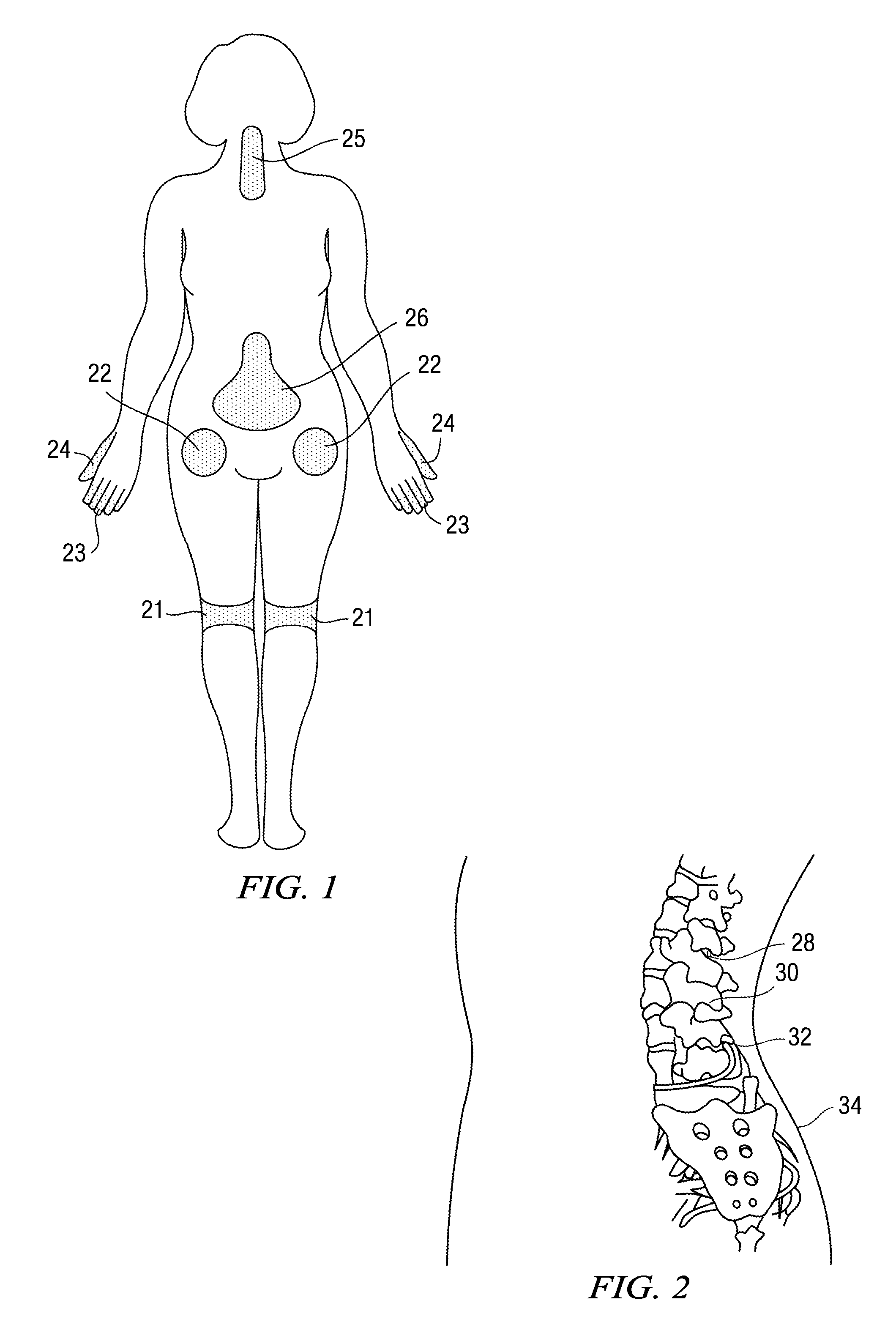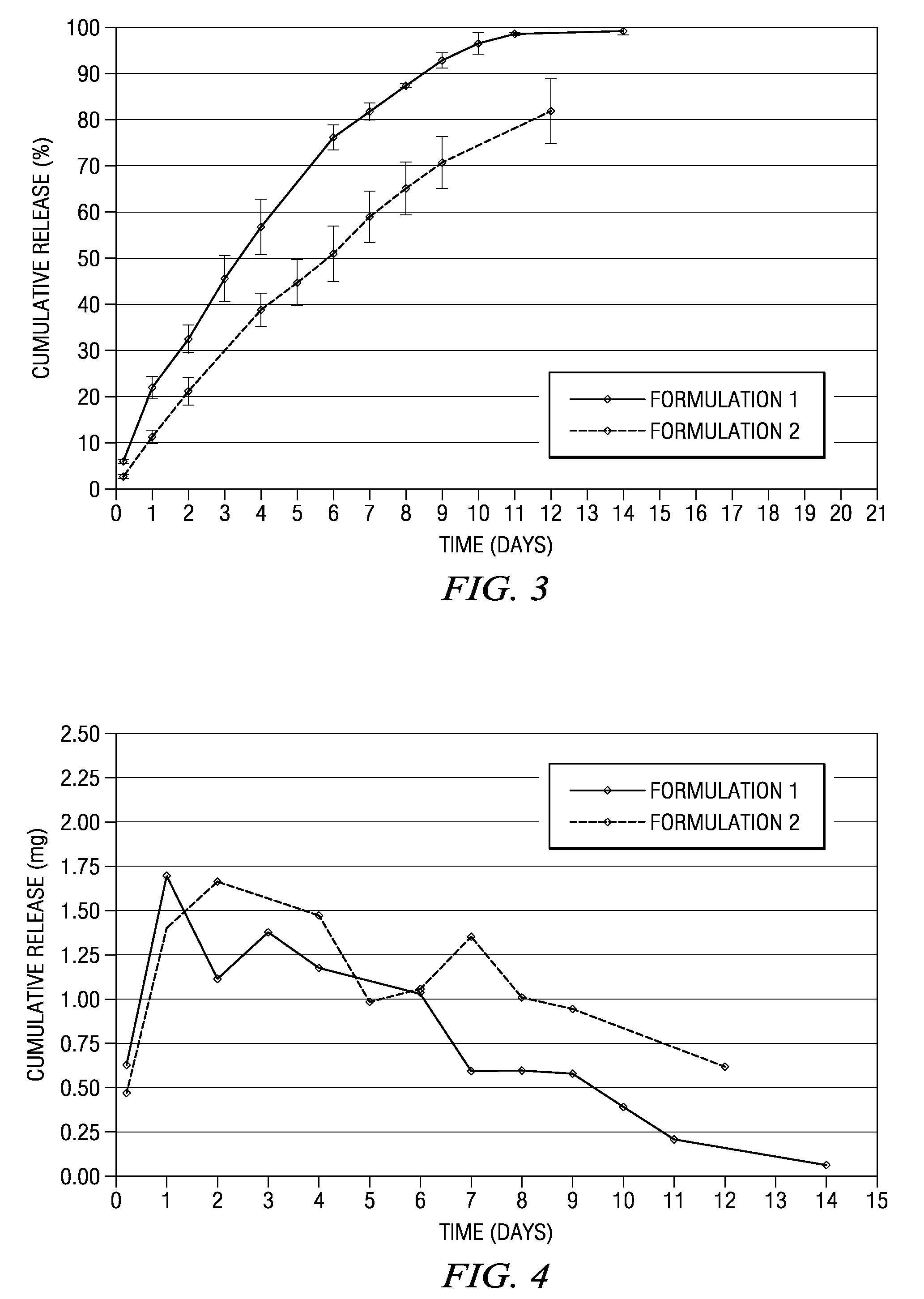Methods and compositions for treating post-operative pain comprising a local anesthetic
a post-operative pain and composition technology, applied in the direction of drug compositions, biocide, anti-inflammatory agents, etc., can solve the problems of reducing increasing so as to reduce the pain of the operation, prevent the effect of post-operative pain and/or inflammation, and facilitate the implantation of the drug depo
- Summary
- Abstract
- Description
- Claims
- Application Information
AI Technical Summary
Benefits of technology
Problems solved by technology
Method used
Image
Examples
example 1
[0173]Implants comprising bupivacaine were prepared according to the following procedures:
[0174]Materials: Poly (D,L-lactide-co-caprolactone) having a 25:75 lactide to caprolactone molar ratio (25:75 DL-CL), an intrinsic viscosity of 0.8 dL / g and a molecular weight of 95 kDa was purchased from Lakeshore Biomaterials (Birmingham, Ala.). Poly (D,L-lactide-co-glycolide-co-caprolactone) having a 30:20:50 lactide to glycolide to caprolactone molar ratio (30:20:50 DL-G-CL), an intrinsic viscosity of 0.05 dL / g to 0.15 dL / g and a molecular weight of 10 kDa was purchased from Lakeshore Biomaterials (Birmingham, Ala.). Bupivacaine Base was purchased from Orgamol (Switzerland). Polyethylene glycol (PEG) having an average molecular weight of 300-400 g / mol was purchased from Spectrum Chemicals, n-methylpyrrolidone (NMP) having an average molecular weight of 99 g / mol was purchased from Fisher, and acetone was also purchased from Sigma-Aldrich.
[0175]Methods:
[0176]Preparation of Bupivacaine base / 25...
example 2
[0184]A number of implants comprising bupivacaine were prepared according to the following procedures:
[0185]Materials: Poly(D,L-lactide-co-glycolide) having a 50:50 lactide to glycolide molar ratio (PLGA 50501A), an intrinsic viscosity of 0.12 and acid end capped polymer chain ends was purchased from Lakeshore Biomaterials (Birmingham, Ala.). Bupivacaine Base was purchased from Orgamol (Switzerland). Bupivacaine HCl was purchased from Spectrum Chemicals (Gardena, Calif.). Methoxy polyethylene glycol (mPEG) having an average molecular weight of 550 was purchased from Sigma-Aldrich. Methanol and acetone was also purchased from Sigma-Aldrich.
[0186]Methods:
[0187]Preparation of Spray Dried Bupivacaine base / PLGA50501A: Bupivacaine base and PLGA50501A were both dissolved in acetone to yield a 10% (w / w) solution. A mixture of 65.2% bupivacaine base solution and 34.8% PLGA50501A solution was spray dried in the Buchi Spray Dryer. The processing parameters were set as follows: inlet temp. (70°...
example 3
[0196]A number of implants comprising bupivacaine base were prepared and their cumulative in vitro release profiles were measured.
[0197]Materials: Poly(D,L-lactide-co-caprolactone) having a 25:75 lactide to caprolactone molar ratio (25:75 DL-CL), an intrinsic viscosity of 0.8 dL / g and a molecular weight of 95 kDa was purchased from Lakeshore Biomaterials (Birmingham, Ala.). Poly(D,L-lactide-co-glycolide-co-caprolactone) having a 30:20:50 lactide to glycolide to caprolactone molar ratio (30:20:50 DL-G-CL), an intrinsic viscosity of 0.05 dL / g to 0.15 dL / g and a molecular weight of 10 kDa was purchased from Lakeshore Biomaterials (Birmingham, Ala.). Bupivacaine base was purchased from Orgamol (Switzerland). The PEG polymers having average molecular weights of 300, 1,500 and 8,000 were purchased from Spectrum Chemicals, n-methylpyrroolidone (NMP) having an average molecular weight of 99 g / mol was purchased from Fisher, and acetone was also purchased from Sigma-Aldrich. Labrosol consisti...
PUM
| Property | Measurement | Unit |
|---|---|---|
| wt. % | aaaaa | aaaaa |
| weight percent | aaaaa | aaaaa |
| weight percent | aaaaa | aaaaa |
Abstract
Description
Claims
Application Information
 Login to View More
Login to View More - R&D
- Intellectual Property
- Life Sciences
- Materials
- Tech Scout
- Unparalleled Data Quality
- Higher Quality Content
- 60% Fewer Hallucinations
Browse by: Latest US Patents, China's latest patents, Technical Efficacy Thesaurus, Application Domain, Technology Topic, Popular Technical Reports.
© 2025 PatSnap. All rights reserved.Legal|Privacy policy|Modern Slavery Act Transparency Statement|Sitemap|About US| Contact US: help@patsnap.com



